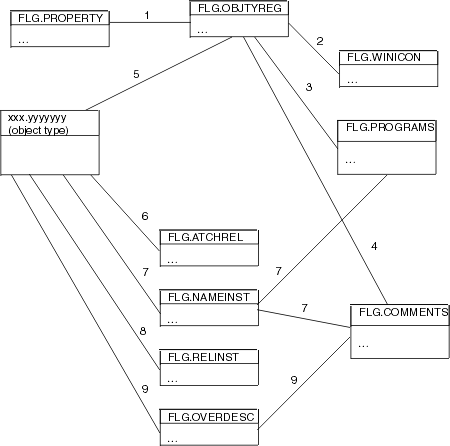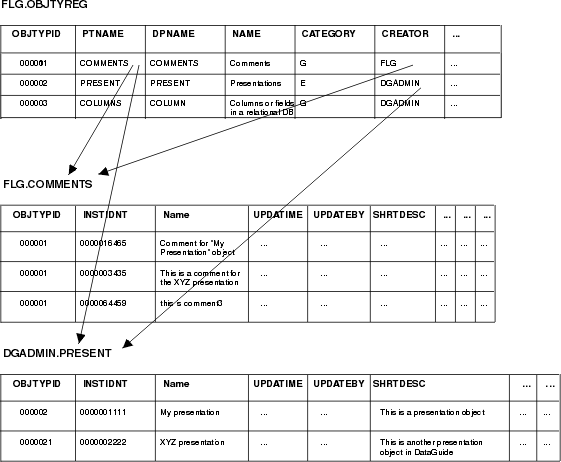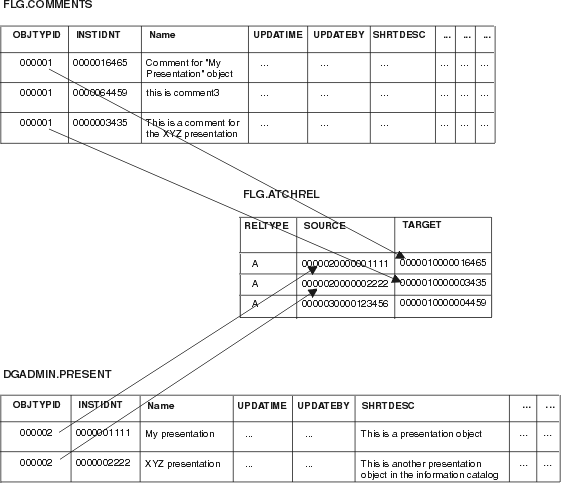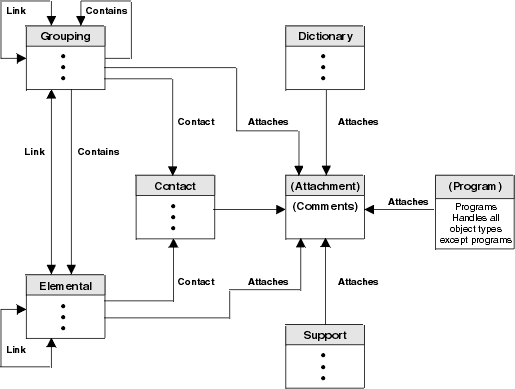Data Warehouse Center Application Integration Guide
The following sections describe the Information Catalog Manager metadata
models. Model for Information Catalog Manager system tables describes the relationships between Information Catalog
Manager system tables. Logical metadata model describes the relationships between objects in the
Information Catalog Manager object type categories.
The following illustrations show the relationships between
the different Information Catalog Manager system tables as well as the
object-type tables. For example, a relationship can be a join between
two columns. The following Information Catalog Manager system tables
are not related to the other system tables:
- FLG.PARMS
- FLG.HISTORY
- FLG.USERS
- FLG.EXCHANGE
- FLG.CHECKPT
See the notes following this figure for each numbered relationship.
Figure 22. Information Catalog Manager system tables

Notes to Figure 22
- The relationship between the two tables exists when the values in the
OBJTYPID columns of the tables are equal. The relationship is a join
between the two tables based on the OBJTYPID column.
- The relationship between the two tables exists when the values in the
OBJTYPID columns of the tables are equal. The relationship is a join
between the two tables based on the OBJTYPID column.
- The relationship between the two tables exists when the values in the
DPNAME and HANDLES columns of the tables are equal. The relationship is
a join between the two tables based on the DPNAME and HANDLES columns.
- The relationship between the tables is derived from the PTNAME and CREATOR
columns of the FLG.OBJTYREG table, and the physical name of the
FLG.COMMENTS table.
For example, in Figure 23, the first entry in the PTNAME column is COMMENTS, and the
first entry in the CREATOR column is FLG. Together these values form
the fully qualified FLG.COMMENTS table name.
Figure 23. Relationship between table FLG.OBJTYREG and the object type table

- The relationship between the FLG.OBJTYPREG table and an object type
table is derived by concatenating the PTNAME and CREATOR columns of the
FLG.OBJTYPREG table. The resulting name is the name of the
object type table.
For example in Figure 23, the second entry in the PTNAME column is PRESENT, and the
second entry in the CREATOR column is DGADMIN. Together these values
form the fully qualified name DGADMIN.PRESENT.
- If a relationship is of type A (attaches), the relationship that is stored
in the FLG.ATCHREL table is derived by concatenating the object type ID
and instance ID of a source table with the object type and instance ID of a
target table.
For example, in Figure 24, the object type and instance ID for DGADMIN.PRESENT
are concatenated in the source column of the FLG.ATCHREL table.
The concatenated object type and instance ID of the associated comment
attached to the presentation object in DGADMIN.PRESENT are stored in
the target column.
Figure 24. Relationship between FLG.ATCHREL table, source, and target

- The relationship between each pair of tables is derived from the FLGID of
the tables. The FLGID represents the concatenation of the OBJTYPID
column and the INSTIDNT column of the tables.
- The relationship stored in FLG.RELINST is for the following
relationships: Contains, Link, and Contact. (See Logical metadata model for more information on object category
relationships.) The relationship is derived from the FLGID columns of
the source table and the target table. See Predefined Information Catalog Manager object types for more information on Information Catalog Manager object
types.
- The relationship between each pair of tables is derived from the FLGID of
the two tables. There might be multiple rows of data in the
FLG.OVERDESC table. If so, the rows are sequenced by the SEQNO
column of the FLG.OVERDESC table.
Every object type must belong to an Information Catalog Manager
category. An object type's category affects how the
Information Catalog Manager handles it. The following list describes
the object types that you can create in each of the Information Catalog
Manager categories:
- Grouping
- Object types that can contain other object types.
- Elemental
- Non-Grouping object types that are the building blocks for other
Information Catalog Manager object types.
- Contact
- Object types that identify a reference for more information about an
object. More information might include the name of the person who
created the information that the object represents, or the department
responsible for maintaining the information.
- Program
- A Programs object type that identifies and describes applications capable
of processing the actual information represented by Information Catalog
Manager objects types. The only object type that belongs to the Program
category is the Programs object type, which is defined when you create an
information catalog.
- Dictionary
- Object types that define terminology that is specific to your
business.
- Support
- Object types that provide additional information about your information
catalog or enterprise.
- Attachment
- A Comments object type that identifies additional information attached to
another Information Catalog Manager object. The only object type that
belongs to the Attachment category is the Comments object type, which is
defined when you create an information catalog.
Table 75 summarizes the relationships among the Information Catalog
Manager object type categories. Figure 25 shows a graphical representation of the
relationships.
Table 75. Information Catalog Manager category relationships
| Category
| Can contain/is contained by
| Links with
| Contacts associated
| Comments attached
| Programs launch from
|
| Grouping
| Contains other Grouping or Elemental objects
| Other Grouping or Elemental objects
| Yes
| Yes
| Yes
|
| Elemental
| Contained by any Grouping object
| Other Grouping or Elemental objects
| Yes
| Yes
| Yes
|
| Contact
| None
| None
| No
| Yes
| Yes
|
| Program
| None
| None
| No
| Yes
| No
|
| Dictionary
| None
| None
| No
| Yes
| Yes
|
| Support
| None
| None
| No
| Yes
| Yes
|
| Attachment
| None
| None
| No
| No
| Yes
|
You can establish object types for your information catalog in any of three
ways:
- Use the object types that come with the Information Catalog Manager in the
sample information catalog (see Predefined Information Catalog Manager object types for information about creating the sample information
catalog and a description of the object types that it includes).
- Modify the object types that come with the Information Catalog Manager to
fit your organization's needs (see Information Catalog Manager
Administration
Guide for information about modifying an object type).
- Create your own object types.
Figure 25 shows how objects within object type categories are
related. In the illustration, parentheses around an object type
category name indicate that an object type category is not extendible.
Parentheses around an object type name indicate that object type is not
extendible. See Information Catalog Manager object types for more information on extendible object types.
Figure 25. Relationships between object type categories

In Figure 25 above, the following relationships are shown:
- Contains
- An object can contain many objects, or an object can be contained by many
objects.
For example, a Grouping object can contain many Elemental objects, and an
Elemental object can be contained by many Grouping objects.
- Link
- An object can be linked to many objects. Objects in a linked
relationship are peers, rather than one being an underlying object of the
other.
For example, a Grouping object can be linked to many Elemental objects, and
an Elemental object can be linked to many Grouping objects.
- Contact
- An object can have many Contact objects associated with it, or one Contact
object can be associated with many objects.
For example, a Grouping object can be associated with many Contact objects,
and a Contact object can be associated with many Grouping and Elemental
objects.
- Attaches
- An object can have many Attachment objects associated with it;
however, one Attachment object can be associated with only one object.
For example, a Grouping object can have many Attachment objects associated
with it; however, one Attachment object can be related to only one
Grouping object.
- Program
- In this relationship, one object type can have many Program object
instances associated with it. However, one Program object instance can
be associated with only one object type.
For example, an Elemental object type can have many Program object
instances associated with it; however, one Program object instance can be
associated with only one object type.
[ Top of Page | Previous Page | Next Page ]




